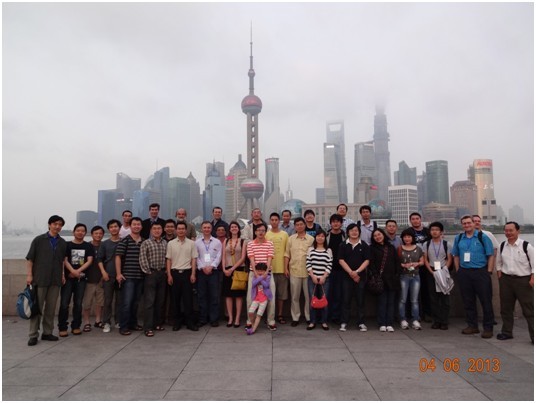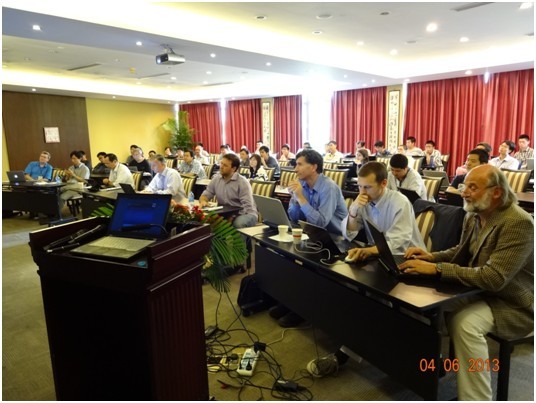
2013 Shanghai Particle Physics and Cosmology Symposium (SPCS2013) was successfully held in Minhang Campus, Shanghai Jiao Tong University (SJTU) on June 3-5, 2013. Professor Haijun Yang, a member of “National 1000-Young-Talent Plan” and “Shanghai 1000-Talent Plan”, served as a chairman of the SPCS2013. Professor Xiangdong Ji, director of Department of Physics and Astronomy at SJTU, announced the commencement of the symposium and expressed warm welcome to the conference participants.

SPCS is an annual symposium hosted by the Institute of Nuclear and Particle, Astronomy and Cosmology at SJTU. SPCS2013 is the third of this annual symposium series, however, it is the first time that American Physical Society (APS) announced the SPCS2013 online, it significantly boosted the international visibility of the SPCS and Department of Physics and Astronomy of SJTU. The purpose of the SPCS is to gather top-notch researchers in particle physics and cosmology, review the major progress of the field, envision possible breakthroughs in the near future, and discuss long-term perspectives. Considering the historic discovery of the Higgs-like boson at LHC in July, 2012 (it was ranked as the greatest discovery by AAAS Science magazine in 2012), the main focuses of the SPCS2013 are Higgs, new physics at LHC and dark matter searches. This symposium will also provide an opportunity to build closer ties between the Chinese and international physics communities and to stimulate fundamental physics researches in China. It offers young scientists the great opportunity to interact with world-class leaders in the field, and interact among themselves as well.
This symposium has more than 50 participants, about 1/4 of participants are foreigners, mainly from the world-class laboratories and top universities such as CERN, Fermilab, SLAC, ANL, RAL, LAL Orsay, MPI, KEK, IHEP, ITP, Stanford U., U. Michigan, U. Wisconsin, U. Tokyo, U. Geneva, RWTH, U. British Columbia, KTH Royal Institute of Technology, Michigan State U., U. Virginia, U. Oregon etc., and from some prestigious domestic universities such as Tsinghua U., Peking U., USTC, CCNU, ECNU, Hongkong U. of Science and Technology etc.

We invited Professor William Murray (RAL) and Professor Christoph Paus (MIT) to present the Higgs highlights from ATLAS and CMS, respectively. Dr. Steve Myers, director of CERN accelerator and technology, presented the current status of the LHC and future plans of CERN in the next 50 years. Professor Alain Blondel of University of Geneva described the current status of international R&D efforts for future colliders and Higgs factory.
Professor Martin Pohl, director of nuclear and particle physics department at University of Geneva presented the latest AMS results about abnormal positron spectrum and possible explanations of dark matter candidate. Professor Xiangdong Ji, spokesperson of the PandaX collaboration, described the latest progress of the PandaX which is a flagship dark matter search experiment led by SJTU. The conference participants were deeply impressed by the rapid progress of the PandaX, and anticipate the first dark matter searching result from the PandaX in the near future.
Professor Keith Riles from the University of Michigan introduced how to catch gravitational waves using LIGO, VIRGO and GEO etc. which are integrated as a global network. With the significant improvement of instruments and detection sensitivity by a factor of ~1000, the advanced LIGO/VIRGO is capable to detect gravitational waves directly in the next 3-5 years. He envisioned an exciting era ahead, that is a new field of astronomy will open soon once the gravitational waves are detected.
The scientific program of SPCS2013 covered wide range of topics, represented the latest results and progresses from many international collaborations such as ATLAS、CMS、 LHCb、D0、CDF、Dayabay、BESIII、RHIC、PandaX、XMASS、AMS、LIGO、Fermi-LAT、muon g-2 and SoLID etc., and many related theoretic talks about Higgs, SUSY, beyond SM and Dark Matter etc.. The detailed program and slides are available at CERN indico conference system which is accessible for all researchers around the world.




